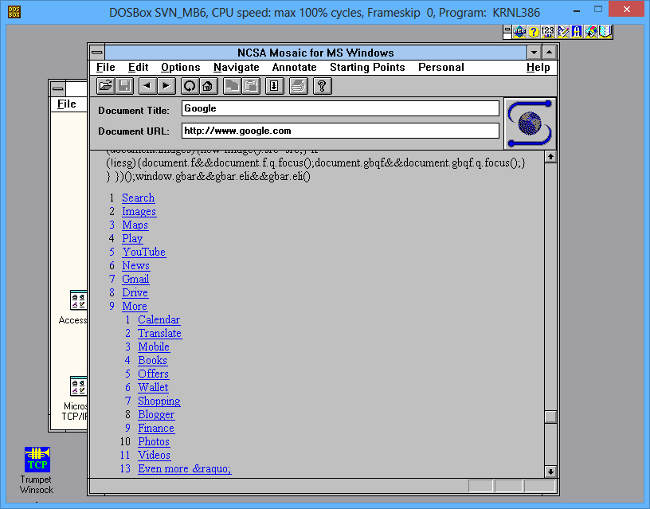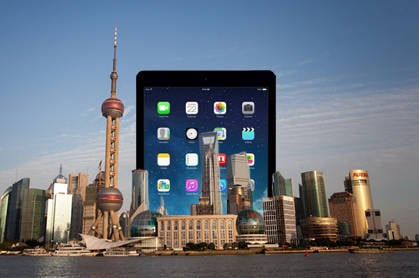Original URL: https://www.theregister.com/2014/03/12/future_of_the_browser_as_web_turns_25/
The browser's resized future in a fragmented www world
The safe option in a native jungle
Posted in Software, 12th March 2014 10:02 GMT
The Web @ 25 "We should work toward a universal linked information system, in which generality and portability are more important than fancy graphics techniques and complex extra facilities."
So wrote Tim Berners-Lee in a document 25 years ago on Wednesday that’s being celebrated as marking the birth date of the web.
Berners-Lee never actually proposed a system for the whole world. What he had in mind when writing that document in 1989 was a system that would help colleagues at CERN solve the riddle of how to share data between themselves.
Call it groupware, call it a big data problem, what it wasn't was "the world wide web" or something intended to revolutionise the internet as it then was.
As such, Berners-Lee was less interested in presentation and more interested by data – both storing it and discovering it.
The story of the web, however, has been dominated by how it is presented – how web pages look. The vehicle for that has been the browser.
App happy?
Berners-Lee’s first browser was a boring text-based thing, an information retrieval tool. It was the browser that got millions first signed up to the web in the 1990s.
Two-and-a-half decades on, this old shovel is getting cast aside and a new tool – the native app – is being taken up to get people online. Question is: is this the future?
The World Wide Web was the byproduct of an answer to an information silo problem tasking the brains at CERN.
The problem at CERN was that it was a huge and growing organisation, facts which made it hard to find data and valuable documents. The challenge was that information was not being stored using a single structure and data was being described in different ways. If you were looking to be pointed in the right direction, it depended on whom you knew.
Berners-Lee's 25-year-old memo proposed a way to search for and retrieve information in such a large and unstructured organisation as CERN.
His answer was hypertext, an idea dating from the 1950s and Ted Nelson.
By 1990, Berners-Lee had built a web server, running on a NeXT system, and a browser – called WorldWideWeb and later Nexus – to access documents.
This was shared with the rest of the high-end physics community in 1991, with CERN releasing the source code for Berners-Lee's browser in 1993. It was the browser that really pulled the mainstream into the web.
Remember Netscape?
Before the release, there had been 500 web servers, but this had grown to 10,000 with 10 million users by the end of 1994. A full 2,000 of these servers were commercial. Today it is estimated that there are nearly one billion websites served by an unknown number of web servers and 2.4 billion users.
Tim Berners-Lee's first browser was simple and text-driven. The first successful browser, Mosaic, used graphics, and was originally the project of wunderkind Marc Andreessen of the National Center for Supercomputing Applications (NCSA) at the University of Illinois.

Google rendered in Mosiac
Andreessen’s Act II, of course, was Netscape Navigator from his Netscape Communications. Netscape catapulted to 90 per cent market share running on Windows, Linux, Mac, OS/2 and many versions of Unix. Netscape went public in 1994, doubling its opening price of $14 a share to hit $75 a share. It was the start of the dot-com bubble, as Netscape soon became the way to view newly created websites.
The browser succeeded by going against the grain of technology at that time. Most systems were built by companies to lock you in to their stack and therefore pay them money over the long term. Being generic and open were key, and websites and browsers worked together using a set of emerging and open common standards, technologies and practices.
Enter Microsoft
The medium of the browser was validated when Microsoft got involved in 1995. Fighting fit startup Microsoft saw the web as threat to the desktop PC hegemony it was rolling out and responded with its own browser, Internet Explorer (IE) in 1995. IE was for Windows and Windows only, and used proprietary APIs and Microsoft code. It set a pattern for IE.
This was the browser wars – wars of market share and annihilation. Microsoft decided to snuff out Netscape by giving away IE for free and making it a condition for PC makers to get Windows and only take IE.
This combined with the fact Netscape couldn’t figure out how to actually make money saw Netscape bought by AOL and eventually shut down in 2003. By 2003, IE had a whooping 96 per cent market share and seemed unassailable.
While Microsoft essentially killed Netscape, it did normalise the web: Microsoft’s presence in mainstream desktop computing also established the concept of the browser.
However, just as Microsoft helped normalize the concept of the browser it also bred a wave of innovation that helped take the browser to new heights.
Innovation came in spite of, not because of Microsoft’s victory.
Redmond OutFoxed
With Netscape gone, Microsoft decided there was no more to do on browser but others disagreed and that led to Mozilla's Firefox, which was based on the old Netscape code, and later the introduction of Google's Chrome and use of WebKit by Apple.
Speed, rendering, tabbed browsing, security and write-once-run-anywhere had been introduced or improved while software was optimised to talk to the hardware – with processing moved off of the CPU to GPU.
Today, video can often be played without proprietary and buggy plugins like Flash.
Gone are the days when the browser was a platform the vendor controlled – a vendor which forced you to trade certain freedoms to simply view or consume the web.
But the future of the browser also now seems less certain and some – including Berners-Lee – talk of the death of the web.
Bugger the browser, there's an app for that

The culprit is the mobile device – both smartphone and tablet – which has given us a new way to go online. The new window for browsing is the native app, which is killing the generic website and the generic website viewer. If you wish to experience the web now, you'll need a special app build for purpose.
I'd be insulting your intelligence if I talked here of the barn-storming commercial success of the smartphone and tablet. Slumping PC sales and surging sales of tablets and smartphones are more than well documented. Christmas 2013 simply continued a trend that is expected to last for another three years of continued growth in tablet and smartphone sales.
Mobile is overtaking the PC as the number one way to go online. Analyst eMarketer estimates 73.4 per cent of internet users in 2013 accessed the web from a mobile device – with the number expected to hit 90.1 per cent in 2017.
What's more intriguing is how this started: that was Steve Jobs' fault. Jobs released a phone whose hardware his company controlled and which was only able to run apps from an online store also controlled by Apple. Generic apps capable of executing on a PC or somebody else's phone or tablet were banned. No Adobe Flash, running on 90 per cent of web-connected PCs and running most of the internet's media and advertising content, for example.
It could never work! It did work. Seven years after the first iPhone was sold, one million apps reside in Apple's store. Microsoft and Google liked it so much, they followed suit, with their own handset plans and their own app stores.
We've all gone native
Application makers have willingly followed the device Pied Pipers. Facebook and LinkedIn, for example, have flirted with generic alternatives built using HTML5 but have spiked these and gone native. The app entrepreneurs like WhatsApp, whom others will now be emulating in the hope of getting bought by Google, are also native so they can also work well on the chosen smartphone or tablet-maker’s underlying hardware.
Native is on a run for two reasons: one, because the app writers were ordered to do so by the app store owners or phone makers and there was too much at stake in saying "no". Two: because tuning the app to the hardware ensured the app performed beautifully and without any crashes. In the case of the social networking apps, native apps had to work with the devices' hardware to be of value – onboard cameras, geo-location features, keypads and other aspects for which there is no single global standard or reference spec.
The success of devices and native apps would seem to confirm the end of the generic website and generic website viewer that is the browser.
But I would offer a counter-theory: the pendulum will swing back and the browser and generic web will find a new home on a new web.
You will soon tire of this... fondlesome-slab
The pressure caused by devices and the collapse of the PC will ease. Growth of smartphones and tablets is expected to slow down by 2017 while sales of new PCs are expected to stop shrinking and stabilise to a new normal.
Those building apps will need to make intelligent bets on what they turn native and what they keep generic. With millions of apps in some companies' app stores, joining that with a native app might not be the best way to come to customer's attention. The more apps there are, the more you get lost in the noise. Building a web app optimised for mobile might be the better way to go, depending on the app in question – say, retail store versus game.
Native is risky: application writers are tied into the roadmaps of hardware makers and app store owners. What happens when the roadmap shifts, breaking changes disable your app, or the app store maker shuts down? What id the handset or software platform is discontinued or pulls out? Native is also confusing: should you invest in the Android or the iPhone version of WhatsApp?
The risks will become more pronounced once growth slows down and the market enters a period of consolidation.
The browser still has some hold-out areas of strength: entertainment, shopping and search remain the three single biggest areas for the browser over native apps, according eMarketer data from a few years back. The browser and the PC could still have a role to play in serving customers who are not satisfied with squinting and poking at a small screen or losing connectivity.
Fragmentation is hurting the PC and the browser, yes, but it can also ensure their future in a world where no one dominates - they just need to right size.
In this world, consuming the web becomes a technology choice, and we have been here before - even in that supposed golden era of the 1990s and 2000s when the web was viewed through the browsers of IE, Firefox, Chrome and Safari. Back then, app authors had to pick the Microsoft stack or the open option.
Companies, retailers especially, are already waking up to this and not swinging with the native app crowd. They are building a version of their website for the iPad and Android but also making sure their sites work on mobile through a browser.
Two-and-a-half decades after Berners-Lee dismissed “fancy graphics techniques”, the way "the web” looks and feels is as important as ever. The question for the next 25 years is how far the fragmentation continues and how the browser can find its equilibrium in this chaos. ®